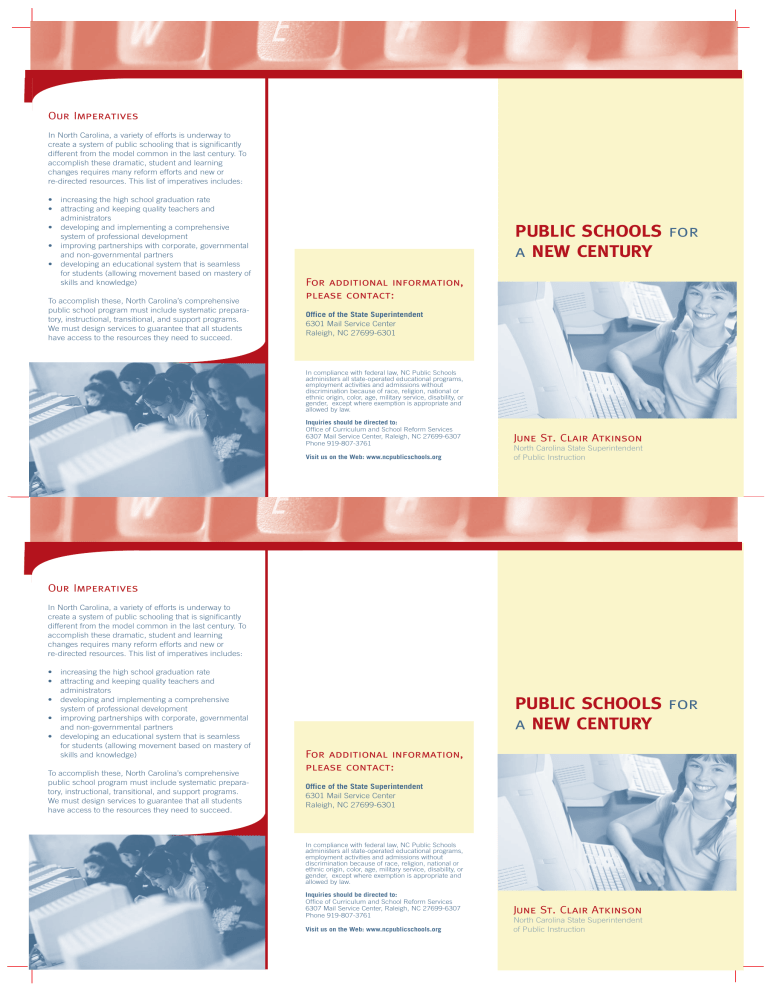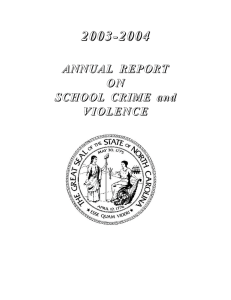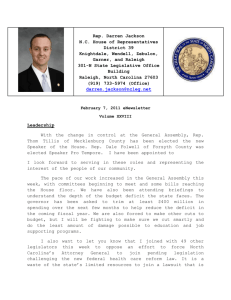Our Imperatives

Our Imperatives
In North Carolina, a variety of efforts is underway to create a system of public schooling that is significantly different from the model common in the last century. To accomplish these dramatic, student and learning changes requires many reform efforts and new or re-directed resources. This list of imperatives includes:
• increasing the high school graduation rate
• attracting and keeping quality teachers and administrators
• developing and implementing a comprehensive system of professional development
• improving partnerships with corporate, governmental and non-governmental partners
• developing an educational system that is seamless for students (allowing movement based on mastery of skills and knowledge)
To accomplish these, North Carolina’s comprehensive public school program must include systematic preparatory, instructional, transitional, and support programs.
We must design services to guarantee that all students have access to the resources they need to succeed.
PUBLIC SCHOOLS
for a
NEW CENTURY
For additional information, please contact:
Office of the State Superintendent
6301 Mail Service Center
Raleigh, NC 27699-6301
In compliance with federal law, NC Public Schools administers all state-operated educational programs, employment activities and admissions without discrimination because of race, religion, national or ethnic origin, color, age, military service, disability, or gender, except where exemption is appropriate and allowed by law.
Inquiries should be directed to:
Office of Curriculum and School Reform Services
6307 Mail Service Center, Raleigh, NC 27699-6307
Phone 919-807-3761
Visit us on the Web: www.ncpublicschools.org
June St. Clair Atkinson
North Carolina State Superintendent of Public Instruction
Our Imperatives
In North Carolina, a variety of efforts is underway to create a system of public schooling that is significantly different from the model common in the last century. To accomplish these dramatic, student and learning changes requires many reform efforts and new or re-directed resources. This list of imperatives includes:
• increasing the high school graduation rate
• attracting and keeping quality teachers and administrators
• developing and implementing a comprehensive system of professional development
• improving partnerships with corporate, governmental and non-governmental partners
• developing an educational system that is seamless for students (allowing movement based on mastery of skills and knowledge)
To accomplish these, North Carolina’s comprehensive public school program must include systematic preparatory, instructional, transitional, and support programs.
We must design services to guarantee that all students have access to the resources they need to succeed.
PUBLIC SCHOOLS
for a
NEW CENTURY
For additional information, please contact:
Office of the State Superintendent
6301 Mail Service Center
Raleigh, NC 27699-6301
In compliance with federal law, NC Public Schools administers all state-operated educational programs, employment activities and admissions without discrimination because of race, religion, national or ethnic origin, color, age, military service, disability, or gender, except where exemption is appropriate and allowed by law.
Inquiries should be directed to:
Office of Curriculum and School Reform Services
6307 Mail Service Center, Raleigh, NC 27699-6307
Phone 919-807-3761
Visit us on the Web: www.ncpublicschools.org
June St. Clair Atkinson
North Carolina State Superintendent of Public Instruction
The Future
Daydream for a moment and picture yourself in a public school classroom in the 21st century. You see students in cubicles that remind you of a television studio. The computers, small as they are, are laserdriven and voice activated. You rarely see any paper.
Students easily change data on the computer screen through a portable laser pen or voice activation. Students receive immediate feedback and evaluation about their work. A teacher is in the vicinity working with a small group of students, but other teachers on the school’s faculty are physically located in all parts of the world.
They teach lessons via telecommunications and virtual reality. Teachers focus on facilitation of learning and the development of relationships.
The Media
You don’t see paper textbooks. Instead, each student has an apparatus about the size of a postcard that contains all of the information in the U.S. Library of Congress.
(Christopher Evans in his book, Micro Millennium, was right when he made that prediction in 1979.) The students’ access to the world’s most famous libraries is a “button” or a “word” away.
The Classroom
Visit a high school where students of every level and interest participate in a rigorous curriculum. They are learning academic content in settings that allow realworld application. Technology-enabled simulations are common learning tools and represent systems involving computer-integrated manufacturing, information management and technology, biotechnology, agriscience, medical prognosis and treatment, automated marketing, environmental, personal and consumer services.
Students practice skills and engage in problem-solving and creativity-building techniques while encountering equipment or people. You will see teachers working closely with students in building social, human relation, and communication skills. After all, oral communication is the main input device to machines. Expert systems also diagnose students’ strengths and weaknesses. They then prescribe activities or strategies that students must use to overcome weaknesses.
The World Brought to School
Take a look at a language class in an international trade program. In one corner, a student is practicing Mandarin
Chinese enunciation. The computer “listens” and
“corrects” the student. Another student is conversing with a Spanish speaker who lives 3,000 miles away.
What the Spanish speaker says is immediately printed on the computer screen, just in case the student does not understand. Other students are encountering other cultures throughout the world by using virtual reality.
The Teachers
In another part of the school, teachers are working with technicians in developing expert systems for the upcoming telecommunications lessons. They are using their own language in devising programs to supplement those that are already in the hardware and software blend of a computer. You will also find some teachers discussing with administrators such topics as: “What skills do students need for tomorrow’s world? What is intelligence? How do we teach thinking skills? How do we develop human potential?” Teachers are supportive and facilitative. They provide students with assistance, feedback, and encouragement in their learning and development.
Our Mission
Empowering students for effective participation in a global economy as world-class workers and citizens.
The Future
Daydream for a moment and picture yourself in a public school classroom in the 21st century. You see students in cubicles that remind you of a television studio. The computers, small as they are, are laserdriven and voice activated. You rarely see any paper.
Students easily change data on the computer screen through a portable laser pen or voice activation. Students receive immediate feedback and evaluation about their work. A teacher is in the vicinity working with a small group of students, but other teachers on the school’s faculty are physically located in all parts of the world.
They teach lessons via telecommunications and virtual reality. Teachers focus on facilitation of learning and the development of relationships.
The Media
You don’t see paper textbooks. Instead, each student has an apparatus about the size of a postcard that contains all of the information in the U.S. Library of Congress.
(Christopher Evans in his book, Micro Millennium, was right when he made that prediction in 1979.) The students’ access to the world’s most famous libraries is a “button” or a “word” away.
The Classroom
Visit a high school where students of every level and interest participate in a rigorous curriculum. They are learning academic content in settings that allow realworld application. Technology-enabled simulations are common learning tools and represent systems involving computer-integrated manufacturing, information management and technology, biotechnology, agriscience, medical prognosis and treatment, automated marketing, environmental, personal and consumer services.
Students practice skills and engage in problem-solving and creativity-building techniques while encountering equipment or people. You will see teachers working closely with students in building social, human relation, and communication skills. After all, oral communication is the main input device to machines. Expert systems also diagnose students’ strengths and weaknesses. They then prescribe activities or strategies that students must use to overcome weaknesses.
The World Brought to School
Take a look at a language class in an international trade program. In one corner, a student is practicing Mandarin
Chinese enunciation. The computer “listens” and
“corrects” the student. Another student is conversing with a Spanish speaker who lives 3,000 miles away.
What the Spanish speaker says is immediately printed on the computer screen, just in case the student does not understand. Other students are encountering other cultures throughout the world by using virtual reality.
The Teachers
In another part of the school, teachers are working with technicians in developing expert systems for the upcoming telecommunications lessons. They are using their own language in devising programs to supplement those that are already in the hardware and software blend of a computer. You will also find some teachers discussing with administrators such topics as: “What skills do students need for tomorrow’s world? What is intelligence? How do we teach thinking skills? How do we develop human potential?” Teachers are supportive and facilitative. They provide students with assistance, feedback, and encouragement in their learning and development.
Our Mission
Empowering students for effective participation in a global economy as world-class workers and citizens.





